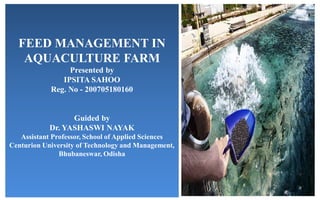
Feed management in aquaculture farm
- 1. FEED MANAGEMENT IN AQUACULTURE FARM Presented by IPSITA SAHOO Reg. No - 200705180160 Guided by Dr. YASHASWI NAYAK Assistant Professor, School of Applied Sciences Centurion University of Technology and Management, Bhubaneswar, Odisha
- 2. Review Literature METHODOLOGY Introduction Categories of fishes based on food preference Basic Food Elements Needed by Fish Feed Types & Feeding Management References Presentation Outline Conclusion Feeding Management Strategies How to choose right fish feed & way of feeding
- 3. Fish feed is a major expenditure for fish farmers. Good fish feed management can reduce overall culture cost, improve fish farm environment and ensure healthy growth of fish stock. Fish feed management includes choosing the right feed, using a correct feeding method, calculating the feeding cost and ensuring the cost effectiveness of fish farm. INTRODUCTION
- 4. Categories of fishes based on food preference Herbivore • Prefers food which are plant- based Carnivore • Eats other aquatic animals Omnivore • Eats both plant and animal- based foods Few ornamental species are categorized as strictly carnivores or herbivores
- 5. Basic Food Elements Needed by Fish Protein provides energy and builds body tissues Carbohydrates source of energy Fats also energy foods reserved energy Vitamins assist in metabolic process in the body • Oil soluble vitamins A, D, E, K • Water soluble vitamins B, C, panthothenic acid, niacine, folic acid and others Minerals regulate fish activities and their physical structure
- 7. Feed Types 1. Vegetarian feed Wheat bran, rice bran, weed, soy dregs, flour and peanut cakes are suitable for freshwater fish. 2. Trash fish Fishing by- catch or small fish is suitable for marine fish. 3. Pellet feed There are dry and moist pellets. The former is more popular. Pellet feed is suitable for both freshwater and marine species.
- 9. How to choose right fish feed By comparing I. The nutritional requirement of the species II. Availability III. Price IV. Storage method V. Hygiene VI. Environmental impacts of different feeds.
- 10. The Correct way of feeding Feeding must not be too much and too quickly. This wastes money and pollutes fish farms. Observe how fish respond to feeding. Low consumption may be a sign of disease or deteriorating water quality. It is best to give frequent feeds in small quantities. If using dry pellet feed, consider having an automatic feeding machine installed to save manpower. By Keeping farm management record helps to control Cost and select the right feed and management approach. It helps to detect potential disease outbreaks at an early stage.
- 11. Feeding Management Strategies Feeding is done at least twice a day For small fishes (live-bearers), feeding can be done based on demand (at satiation level). Artificial feeds such as finfish feeds, prawn feeds or combination of rice bran fish meal (20-30 fish meal, 80-70 rice bran) commonly used as feeds. Broodstock given high protein foods. Larvae or fry given tiny live foods (infusoria, Artemia, Moina) Juveniles could be given commercial feeds. Feeding is done gradually, making sure all fish have eaten. Feeds must be evenly distributed to the grow-out areas. Avoid wastage of feeds
- 12. Feeding management is One of the important aspects in the breeding and culture of fishes. Feeds must be cost-effective and efficient. Proper management of feed gives better yield. CONCLUSION
- 13. Abban, E. K. (2005). Study and analysis of feed and nutrients including fertilizers for sustainable aquaculture development in Ghana (unpublished report of the Water Research Institute, Council for Scientific & Industrial Research). Accra, Ghana, Council for Scientific & Industrial Research, 24. Hasan, M. R. (2010). On-farm feeding and feed management in aquaculture. FAO Aquaculture Newsletter, (45), 48. Goddard, S. (2012). Feed management in intensive aquaculture. Springer Science & Business Media. Schwarz, M. H., van Senten, J., Jahncke, M. L., & Lazur, A. M. (2019). Overview of good aquaculture practices. REFERENCES
